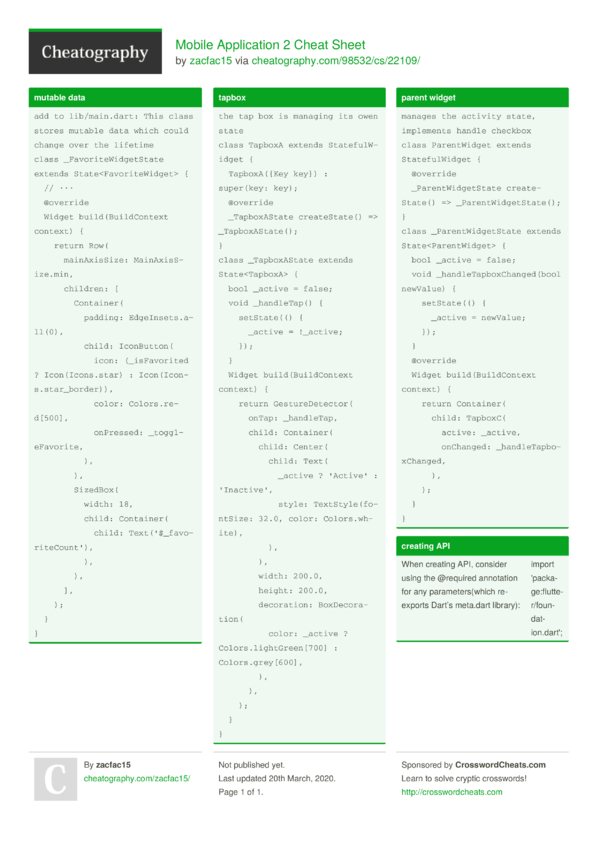new_releases The content of this site is historical. See the announcement for updates.
Dart Cheat Sheet Learning a new framework is a daunting task. And it is totally nightmarish if a new language is used. Such is the case for learning Flutter, where the language used is Dart.
Bootstrapping
import 'package:angular/angular.dart';

- The cheat sheet references main classes and methods from Dart SDK.
- A complete Dart cheat sheet for everyday use (from beginners to advanced users) JavaScript Cheat Sheet From basic setup to DOM manipulation to the latest ECMA script features.

import 'package:angular_app/app_component.template.dart' as ng;Technic launcher download mac.
void main() {
runApp(ng.AppComponentNgFactory);
}Launch the app, using
AppComponentas the root component.See: Architecture Overview,Dependency Injection
import 'package:angular_router/angular_router.dart';
import 'package:angular_tour_of_heroes/app_component.template.dart' as ng;
import 'main.template.dart' as self;
@GenerateInjector(
routerProviders,
)
final InjectorFactory injector = self.injector$Injector;
void main() {
runApp(ng.AppComponentNgFactory, createInjector: injector);
}Launch the app, using a compile-time generated root injector.
See: Architecture Overview,Dependency Injection
| Template syntax | ||
|---|---|---|
<input [value]='firstName'> | Binds property See: Template Syntax | |
<div [attr.role]='myAriaRole'> | Binds attribute See: Template Syntax | |
<div [class.extra-sparkle]='isDelightful'> | Binds the presence of the CSS class See: Template Syntax | |
<div [style.width.px]='mySize'> | Binds style property See: Template Syntax | |
<button (click)='readRainbow($event)'> | Calls method See: Template Syntax | |
<div> | Binds a property to an interpolated string, for example, “Hello Seabiscuit”. Equivalent to: See: Template Syntax | |
<p>Hello {{ponyName}}</p> | Binds text content to an interpolated string, for example, “Hello Seabiscuit”. See: Template Syntax | |
<my-cmp [(title)]='name'> | Sets up two-way data binding. Equivalent to: See: Template Syntax | |
<video #movieplayer ..> | Creates a local variable | The See: Template Syntax |
<p> | Transforms the current value of expression See: Template Syntax | |
<p> | The safe navigation operator ( See: Template Syntax |
| Core directives | import 'package:angular/angular.dart'; Available from CORE_DIRECTIVES |
|---|---|
<section *ngIf='showSection'> | Removes or recreates a portion of the DOM tree based on the See: Template Syntax, NgIf class |
<li *ngFor='let item of list'> | Turns the li element and its contents into a template, and uses that to instantiate a view for each item in list. See: Template Syntax, NgFor class |
<div [ngSwitch]='conditionExpression'> | Conditionally swaps the contents of the div by selecting one of the embedded templates based on the current value of conditionExpression. See: Template Syntax, NgSwitch class, NgSwitchCase class, NgSwitchDefault class |
<div [ngClass]='{active: isActive, disabled: isDisabled}'> | Binds the presence of CSS classes on the element to the truthiness of the associated map values. The right-hand expression should return {class-name: true/false} map. See: Template Syntax, NgClass class |
| Forms | import 'package:angular_forms/angular_forms.dart';Available from formDirectives |
|---|---|
<input [(ngModel)]='userName'> | Provides two-way>). See: Template Syntax, Input class |
final _myEvent = new StreamController<T>(); | Declares an output property that fires events that you can subscribe to with an event binding (example: See: Template Syntax, Output class |
@HostBinding('class.valid') isValid; | Binds a host element property (here, the CSS class See: HostBinding class |
@HostListener('click', ['$event']) | Subscribes to a host element event ( Download photos from iphone 7 to mac. See: Attribute Directives, HostListener class |
@ContentChild(myPredicate) myChildComponent; | Binds the first result of the component content query ( See: ContentChild class |
@ContentChildren(myPredicate) myChildComponents; | Binds the results of the component content query ( See: ContentChildren class |
@ViewChild(myPredicate) myChildComponent; | Binds the first result of the component view query ( See: ViewChild class |
@ViewChildren(myPredicate) myChildComponents; | Binds the results of the component view query ( See: ViewChildren class |
301 Out Chart Printable
| Directive and component change detection and lifecycle hooks | (implemented as class methods) |
|---|---|
MyAppComponent(MyService myService, ..) { .. } | Called before any other lifecycle hook. Use it to inject dependencies, but avoid any serious work here. See: Lifecycle Hooks |
ngOnChanges(changeRecord) { .. } | Called after every change to input properties and before processing content or child views. See: Lifecycle Hooks,OnChanges class |
ngOnInit() { .. } | Called after the constructor, initializing input properties, and the first call to See: Lifecycle Hooks,OnInit class |
ngDoCheck() { .. } | Called every time that the input properties of a component or a directive are checked. Use it to extend change detection by performing a custom check. See: Lifecycle Hooks,DoCheck class |
ngAfterContentInit() { .. } | Called after ngOnInit when the component’s or directive’s content has been initialized. See: Lifecycle Hooks,AfterContentInit class |
ngAfterContentChecked() { .. } | Called after every check of the component’s or directive’s content. See: Lifecycle Hooks,AfterContentChecked class |
ngAfterViewInit() { .. } | Called after See: Lifecycle Hooks,AfterViewInit class |
ngAfterViewChecked() { .. } | Called after every check of the component’s view. Applies to components only. See: Lifecycle Hooks,AfterViewChecked class |
ngOnDestroy() { .. } | Called once, before the instance is destroyed. See: Lifecycle Hooks,OnDestroy class |
| Dependency injection configuration | import 'package:angular/angular.dart'; |
|---|---|
Provider(MyService, useClass: MyMockService) | Sets or overrides the provider for See: Dependency Injection, provide function, Provider class |
Provider(MyService, useFactory: myFactory) | Sets or overrides the provider for See: Dependency Injection, provide function, Provider class |
Provider(MyValue, useValue: 42) | Sets or overrides the provider for See: Dependency Injection, provide function, Provider class |
Angular Dart Cheat Sheet
| Routing and navigation | import 'package:angular_router/angular_router.dart'; |
|---|---|
new RouteDefinition( | Basic unit used to configure routes. See: Tutorial: Routing, RouteDefinition class |
<router-outlet [routes]='routes'></router-outlet> | Reserves a location in the DOM as an outlet for the router. See: Tutorial: Routing, RouterOutlet class |
<a routerLink='/heroes/{{hero.id}}'>..</a> | Creates a link to a different view. See: Tutorial: Routing, RouterLink class |
